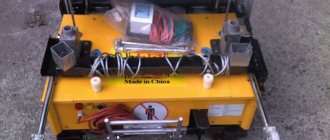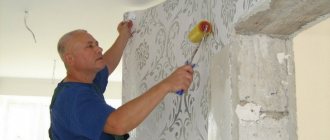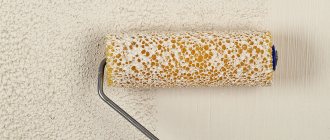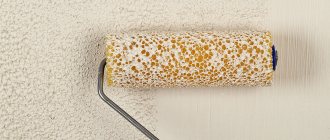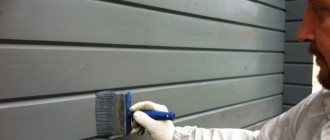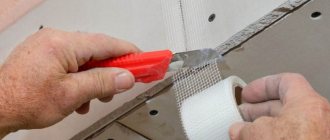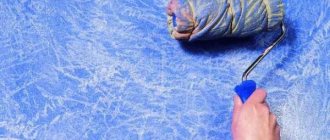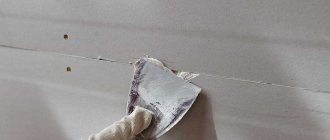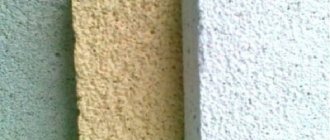Technology of applying putty to the wall with a roller
Tool
Most people associate applying plaster with a trowel. But most often it is used only for leveling walls, applying a thick dense layer of material, and other complex manipulations. But to prepare walls for applying paint/wallpapering or to create a beautiful texture, it is more advisable to use a roller.
The article will discuss in what cases you can and should use a roller and how to use it correctly.
Textured and structural rollers - what they are, features of their use
The device consists of a rotating cylinder on a curved handle with a variety of coatings that create artistic elements. The textured roller imprints a three-dimensional pattern on the newly applied plaster layer. For example, this way you can imitate brickwork or, using a variety with fur, create an aesthetic roughness. A structural roller is used to apply repeating decor with paint on a dry surface; working with this technique may seem more difficult due to the fact that you need to avoid smudges, but it is easy to learn. This technique is used to decorate wood and fabric.
The textured roller imprints a three-dimensional pattern on the newly applied plaster layer.
Applying putty with a brush. Can putty be applied with a paint brush?
/// Is it possible to apply putty using a paint brush?
We have a battery under our window, which cannot be removed - the pipes are old, the threaded connections have become stuck over time and you can simply rip them off. We are doing some cosmetic repairs and have come to this battery. The wall behind it is plastered with lime mortar. I want to make a bespeschanka in this area. It's impossible to get to it with a spatula. And if I use a curved brush for batteries, can I apply a layer of putty with it? If so, what kind of putty should I use and what consistency should it be?
you reminded me of me in my youth, when I covered the entire wall with putty under a brush) You can do this, but the layer will be thin and there will be stains, sanding will be problematic. But it’s still not visible, so what difference does it make, it’s clean and good. But the putty will not stick to every surface without first cleaning it. If you have a thin layer of lime there, first prime it with an acrylic primer twice, but unfortunately no one can give you a 100% guarantee that the putty will not fall off without completely cleaning the base.
You won't be able to apply putty properly this way. To apply it with a brush it must be very liquid. It is better to attach an extension to the spatula and putty with such a device in those places where you cannot reach it. But still, most of it can be easily removed with a regular spatula.
This kind of work cannot be fully completed with a brush; you end up with circles and roughness that can also be cleaned up with sandpaper; just prime this part and, after drying, apply the finishing touch on top, be it paint, plaster or wallpaper.
Instead of coming up with all sorts of tricks, it’s easier to remove the battery while it’s summer and then screw it back in place, just unscrew two couplings.
СryukOff: July 10, 2015 at 0:01
Instead of coming up with all sorts of tricks, it’s easier to remove the battery while it’s summer and then screw it back in place, just unscrew two couplings.
Unscrewing means exerting force, tearing off the nuts. They are all stuck there, so you can break a pipe and flood your and your neighbor’s apartment with water. Therefore, I am more inclined to use the option of “masking” roughness and unevenness. Against the background of a zebra, for example.
Technology No. 3 – creating texture
The most interesting method, in my opinion, since with its help you can achieve very original results, and the number of possible options is simply huge and depends on your imagination and desire to create. I'll just cover a few ways to finish with rollers, but you can use this information as a guide and come up with your own solutions.
I will not list the materials, since their list is the same as in the section above. Here it is much more important to understand the tool, since both the quality of application and the result obtained depend on it. First you need to decide which roller to putty the walls with, especially since there are simply a huge number of solutions.
Let's look at some of them:
There are simply a huge number of invoices
- Rubber options most often have some kind of texture or pattern on the surface; you just need to run a tool over the surface and a certain mark will remain on it. You need to choose the type that suits your interior and will allow you to create the desired texture or pattern. It is best to look at the options on the Internet in order to have an approximate idea of what you need, rather than looking for just anything;
Rubber rollers leave a certain impression
- Rollers made of textile materials can create very interesting structures; they do not have a specific clear pattern, but create a chaotic texture, so working with them is more convenient and easier;
Such rollers create a very interesting texture
- Fabric rollers can be different - from durable flaps to material collected in a certain way. The texture applied to it also depends on the type of product, so you always need to understand what kind of structure this or that option will create;
Fabric rollers are also popular
- Leather rollers create a very interesting texture; due to the strength of the material, they are very durable, which is why they are often used by professionals. Products may have different appearances, therefore the effects may vary.
Leather rollers are durable
You can also find other options made from sponge, foam rubber, fur, plastic, etc. You can also make a roller yourself. To do this, you can attach fabric, pieces of leather or other material to an old roller; it all depends on your imagination.
I can suggest one interesting and simple option: take any standard roller, and simply wind the twine onto it in a chaotic manner. At the end, you need to tie the twine and trim off the excess ends, in the end you will have a tool with which you can apply the ideal structure to the surface.
You can make a tool for the job yourself, it’s simple
In addition to the roller, you will need a brush and two spatulas - wide and narrow, with their help we will apply the composition to the surface.
If in previous cases the walls were puttyed with a roller, then here it will be used as a tool for applying texture. But let's look at all the work in order:
- First of all, it is necessary to apply a primer to the surface, everything is standard here, so we will not stop at this stage;
- The putty is being prepared, and it should not have a runny consistency, it should be the same as usual, because we will apply it with spatulas. The amount of composition may be different, because it dries for a very long time, and if you do not use it in one day, then you can put the mass in a closed container, and it will last even two days without changing its properties, but it is better to use it the next day;
- The composition is applied to the walls as with ordinary putty, it is important to remember only one thing: in order to create a clear texture, the layer should be approximately 3 mm. The work is carried out in separate sections, the composition is applied and left for 10-15 minutes so that the surface begins to dry out, this will simplify further work. It’s best to act together in general - one strikes, the other follows, then you don’t have to run back and forth and constantly switch;
The composition is distributed in a fairly thick layer
- As for applying the texture, if you have a clear pattern or ornament, then you need to run it over the surface once with moderate pressure so that the pattern is clearly imprinted. If the structure is chaotic, then you can move the tool in different ways, the main thing is to do it uniformly over the entire surface, so that in the end you get the same texture, it’s worth figuring it out experimentally, you’ll figure it out quickly;
When working with a roller with a clear texture, you need to move it carefully
- Work continues until the entire surface is finished; the texture can be applied to any type of putty, including cement-based ones. If desired, you can even make the surface with different rollers so that the structure is different and creates an interesting decorative effect;
Can be used with different rollers
- After drying, you can apply a primer to the surface and then paint it. As a result, you will get a very interesting finish, for which you will spend no more than regular putty.
You can apply paint in two layers to give the surface more expressiveness.
What types of putty can the roller handle?
Of course, it will not be possible to level crooked walls with one roller. Even in several approaches. Unless you use it simply as a tool for application, and then again smooth it out with a spatula. But is it worth it? Applying putty with a roller is no easier or faster. Therefore, this tool is used for puttying mainly in two cases: when it is necessary to “whiten” a surface that has already been leveled with plaster or another relatively flat surface, to give it an even color for subsequent painting or wallpapering. Or to create a decorative texture.
Leveling putty
For those who do not know how to putty at all, but want to prepare walls or ceilings for wallpaper or painting, experts advise using a special method - “scraping” putty with a roller. The instructions below will help you understand what this is. But first, let us remind you: this method is only suitable for flat surfaces. For example, walls or ceilings made of plasterboard:
- First, complete all the preparatory work: sealing drywall seams, eliminating gross defects. There is a lot of information on how to do this correctly on the site. You don't need mastery of a spatula here, you can do it easily;
- After the seams have dried, treat the entire surface with a deep penetration primer and wait until it dries;
- Prepare a fur roller with a pile 2-3 mm long and a large spatula with a working surface of at least 60 cm;
- Puttying drywall with a roller is done in the same way as painting - just dip the tool in the solution and roll it over the wall;
Advice. The solution for this work should be of a thinner consistency than usual. It is best to choose ready-made putties or mixtures with a long hardening period.
- After treating a small area, take a spatula and literally rip off the mixture applied to the surface with it, holding it at an angle of 90 degrees to the surface;
- All the putty, of course, will not be removed, but you don’t need that. It will fill all the pores and irregularities and will remain a thin layer on the wall/ceiling;
- Walk this way over the entire surface, let it dry and repeat the procedure one or two more times, depending on how satisfied you are with the result. Moreover, each time the stripping should be done in the direction opposite to the previous one.
This type of puttying with a roller guarantees high-quality leveling of plastered walls - it helps to get rid of roughness and creates a durable, uniform coating. A professional finisher, using a spatula, will cope with such work in one approach, immediately applying a layer of putty of the required thickness. Without experience, you will not repeat this trick, besides, several thin layers are always more reliable than one thick one.
Advice. If at the end of the work there are traces of the spatula left on the surface, they can be removed by sanding with fine emery cloth.
Decorative putty
If the first method is not known to everyone, and is perceived by many experts with a degree of sarcasm, then decorative puttying of walls with a roller is a very common finishing option. True, it is performed completely differently. It is worth noting that anyone can master this method - it does not require perfect smoothing of the surface. Of course, provided that the base is again fairly level. If you want to cover the walls with textured putty yourself, you have to do the following:
- After traditional preparation, priming and drying, apply putty to part of the wall, trying to distribute it in a layer of equal thickness;
- Special precision is not needed here; small errors are quite acceptable. Just as you don’t have to try not to leave marks from the spatula;
Advice. Before you begin, practice on a large piece of drywall or an inconspicuous area of the wall to get the hang of it and understand how to achieve the desired thickness of putty.
- In this case, it is advisable to use ready-made putty - it has an optimal consistency and takes longer to set. Its price is higher than that of dry mixtures, but it can be mixed with tinting pastes, immediately obtaining the desired surface color and saving on paint;
- While the solution on the treated area is still fresh, take a special roller with an ornament or design applied to it and roll it in one motion from top to bottom along the entire height of the wall;
Materials and tools
At the preparation stage, you should purchase all the necessary materials, tools and consumables that may be useful:
- Putty. For finishing walls and ceilings, it is better to immediately buy the highest quality material. The efficiency of the work will depend on the degree of reliability of the building mixture. Mixtures of the Vetonit and Shitrok brands, which are sold in dry form, have proven themselves to be quite good. There are also ready-made formulations on sale that do not require dilution, although their cost is much higher.
- Primer. Typically, deep penetration soils are used to prepare foundations. If walls or ceilings are being finished in conditions of high humidity, antiseptic additives must be present in the soil. You shouldn’t take too cheap products either - their quality does not always correspond to what is needed.
- Serpyanka and putty for sealing seams. Such materials are needed when processing seams between sheets of drywall. The amount of mesh and putty is calculated based on the number and total area of the joints.
- Roller. The best tool for puttying is a short-haired tool (about 3-5 mm) made of durable synthetic or fur 40-60 cm long. With its help, you can apply the material evenly and beautifully. If the pile on the roller is long, the mixture will be applied in a layer that is too thick and difficult to smooth out. The same tool can be used to apply primer, although many people buy a brush for this purpose.
- Putty knife. To work with hard-to-reach areas and corners, you should immediately purchase a medium-sized stainless steel spatula.
- Construction mixer. This device will be required when diluting dry putty mixture. If you don’t have a mixer, you can use a drill with an appropriate attachment or do all the manipulations manually.
- Curly roller. This tool works like a stencil. It is intended for processing decorative mixtures.
Types of putty for roller application and workflow
It is almost impossible to level walls that are too crooked with a roller. It is worth using it if the base is already quite flat, or if you need to make decorative cladding.
Leveling putty
For beginners, the stripping roller puttying method is ideal. It is suitable for finishing smooth plasterboard walls or well-leveled bases. First, they prepare the walls or ceiling - remove dirt, eliminate any, even small, defects and seal seams and joints. Then apply a primer and let it dry thoroughly. This step will help improve the adhesion strength of the base to the putty and bind any remaining dust, as well as strengthen the rough coating.
Then they work like this:
- dip the roller in putty and carefully roll it over the surface;
- they try to fill all the pores with material so that not the slightest dry area remains on the wall;
- after finishing 1-2 square meters of surface, take a spatula and, as it were, rip off the mortar from the wall, holding the tool at an angle of 90 degrees (this stage is needed to fill even tiny defects and leave only a thin layer of material on the wall);
- pass with a roller over the remaining areas, then use a spatula in the same way;
- Allow the material to dry; if necessary, repeat all stages of work again, but peel in the opposite direction.
For this technology, putty with a more liquid texture than usual is suitable. Solutions with a long hardening period, which are sold in finished form, are ideal for this purpose. If, after drying, small imperfections remain on the wall, they can be removed by sanding with fine sandpaper.
Decorative putty
Applying decorative materials is considered a simpler method, so even a beginner can handle it. You can work with a roller on a base that is not too smooth - all defects will still be hidden, although, of course, there should be no serious flaws.
Advantages and disadvantages of puttying with a roller
Puttying walls under wallpaper or other finishing options can be done using a roller. This tool is very popular among professionals, and working with it has a number of advantages:
- there are no traces left on the surface of the walls or ceiling, which are often caused by a spatula or other devices;
- it is possible to apply the putty in a very thin layer, especially when using a liquid solution;
- the completed layer quickly hardens, as it lies in a uniform layer without thickening;
- the risk of coating cracking when applied with a roller is greatly reduced;
- it is possible to save on material and also complete all work much faster, which is very important when processing large areas;
- Finishing the ceiling with a roller is much easier to do, especially when using a tool with a long handle.
There are also disadvantages to this surface puttying technology. The putty roller must be dipped into a large container, therefore, you will have to transfer the mixture if it is in small buckets or jars. Using a roller will require some experience - beginners may not be able to perfectly level walls right away. If it is necessary to smooth out defects, one layer of putty is not enough; you will have to go over the surface 2-3 times. Other disadvantages of the technology:
- A roller will not be suitable for applying putty if there are protruding fasteners on the base;
- a roller will not be able to smooth out every building mixture - if there is thick putty, you will only have to use a spatula or trowel;
- working with a roller requires vigorous action, and people with problems with the musculoskeletal system will find it difficult;
- for hard-to-reach places you will still have to use a spatula, because the roller simply will not fit there;
- Using a roller, it is impossible to perfectly align external and internal corners, as well as seal perforated corners, which are often used to strengthen joints between walls and ceilings.
If you intend to apply putty in a layer of 1-2 cm, it is better to immediately purchase a spatula for the job. It will be impossible to create such a thick layer with a roller.
Technology 2: applying a textured coat to the walls
This technology allows for decorative finishing. Its advantage is that there may be cracks and small flaws on the wall that do not need to be repaired, because... the texture will cover all the irregularities.
Materials and tools for performing work
To apply the putty you will need a foam or wool roller. The longer the pile (wool) or the larger the texture (foam), the greater the relief.
To make a fur coat colored, you will need a dye.
Puttying workflow
The working surface is treated with primer, wait until it dries completely, and then begin applying the textured coat. The dye can be immediately added to the putty, which will save time. Another option is to paint the wall with a spray gun after the mixture has dried.
Puttying the walls with a roller should be done from the corner (or joint) with uniform translational movements in one direction, for example, up and down or left and right. In one go, you need to immediately process the entire wall (from corner to corner).
Post-processing of walls
As the applied mixture dries, the final finishing of the walls begins. Excess putty, if any, is removed by sanding. As a result, the layer of material will become even and smooth. Afterwards, a primer is applied, which will reduce the risk of cracking of the finish and reduce its absorbency. Then you can begin the final decoration of the surface - paint, varnish, wallpaper.
Puttying with a roller is not a very complicated, but responsible process. With sufficient skill, it passes quickly and efficiently. In a short period of time, you can decorate an entire room, so this technique is quite popular among professionals.
Filling cracks
Applying finishing putty to a wall before painting requires filling the cracks. That is why the final coating is very rarely applied right away.
Gypsum putty is used to fill defects, dents, and cracks. First, you need to use a brush to remove dust and dirt, then cover the dent with the material. Gypsum takes a long time to dry, so you will have to wait at least several hours for complete drying. After this, the coating is smoothed with sandpaper so that there are no bumps left on it.
Is it possible to apply finishing putty to drywall if the coating is damaged? Yes, it is only recommended to seal the damage and completely cover the surface.
If the crack is large, it is recommended to scratch its surface with a small knife. This will improve adhesion, since the crack cavity cannot be perfectly cleaned anyway.
To fill minimal damage, a primer is used, the use of which is relevant in any case.
Is it possible to apply finishing putty with a roller to previously damaged walls - yes, it is possible. True, the distribution of the thin layer can be made more accurate with spatulas - the choice is up to the person doing the repairs.
Technology 1: scratch-off surface putty
When the working surface does not have large flaws, you can use the “scraping” technique. The technology is well suited for people who have no experience in the construction profession. Experienced craftsmen do not use this technique, because... consider it time-consuming. But putty applied with a roller and then removing uneven surfaces with a spatula will be smooth and well suited for wallpaper or painting the surface.
Materials and tools
Additionally, you may need a construction mixer and a drill if dry putty was selected when purchasing. Trying to mix the composition with your hands is impractical. This work will take a lot of time and effort. But in cases where it is not possible to use additional tools, you should not prepare a large amount of working material at once.
Workflow Description
Work begins with cleaning the surface. You need to walk along the wall/ceiling with a napkin to remove cobwebs, dust, etc. Before applying putty with a roller, you should treat the walls with primer. It is necessary to follow the instructions indicated on the packaging (the composition may be concentrated, so it will additionally need to be diluted with water).
The roller or brush is dipped into the soil and then applied to the work surface. The composition should penetrate into all cracks and seams. To proceed to the next stage, you need to wait until the soil dries.
If the working surface is made of plasterboard, cover the heads of the screws and seal the seams (using sepryanka). It is necessary to ensure that the applied layer of putty does not protrude, but is flush with the wall. When the building mixture dries, you need to go over it again with soil.
Applying putty with a roller is no different from painting. The composition should lie on the work surface in a thin layer. At the next stage, take a spatula (you don’t have to wait for it to dry), apply it at an angle of 80°-85° and begin to remove the putty. This technique allows you to fill all existing cracks. To get the smoothest possible surface, after drying you should use fine sandpaper.
The work is completed by removing dust and treating the soil surface.
Decorative finishing "fur coat"
Novice craftsmen doubt whether it is possible to apply finishing putty with a roller. In fact, professionals often do the final puttying with this tool. This finishing option is called “fur coat”; it is the simplest and most effective way to create a decorative coating using putty.
To perform decoration, the surface must be smooth, only minor defects are acceptable. Before you begin, you need to prepare all the materials and tools that may be required:
- Putty. It is better to choose a ready-made mixture, as it will be of higher quality and also have the necessary consistency.
- Primer. This is a mandatory material that will be needed both at the initial stage and in the final part of the finishing.
- Pigment for putty. It will allow you to avoid painting and immediately create the surface of the required shade.
- Brush. Used for applying primer or putty in hard-to-reach places.
- Roller. This tool should be chosen depending on the desired effect. There are fur and foam rubber, large and small textures.
When choosing a tool, you should take into account the length of the pile: the longer it is, the more prominently the putty will be applied to the base.
The process of applying the finishing putty with a roller does not cause any difficulties. First, you need to cover the entire surface with a primer solution, then, after waiting for complete drying (at least a day), proceed to the next step - preparing the putty. Initially, it is better to make a thinner composition and adjust the density as you work. If necessary, a coloring pigment is added at this stage.
Painting walls after plastering
+7 | We work seven days a week!
Painting plastered walls
- Home >
- Our services >
- Painting walls after plastering
Before applying the finishing touch to the walls inside an apartment, private house, office or other premises, the surfaces require preliminary preparation. High-quality painting of plastered walls ensures the durability of the paint and varnish coating and is an effective way to create an aesthetically attractive interior. You can order wall painting after plastering from our company by email
When decoratively painting walls, paint and varnish compositions can be applied not to smooth, but to textured and embossed plastered surfaces.
Before painting, finishers check the evenness and general condition of the walls. Painting of putty walls is carried out with the application of a deep penetration primer solution, which prevents the formation of fungus on the plastered surface and improves its adhesion to the layer of paint material.
Decorative putty with a roller
Putty, especially decorative, looks very impressive. And it seems that only professionals can do such work. But this is a fairly simple method of creative finishing. Roller putty has been used as an application technology for many years.
The surface finished using this technology looks great, which is why it has been popular for many years. Small irregularities on the surface do not matter; a flat plane is sufficient.
A primer is applied to a leveled surface, plastered or puttied, sometimes twice. When the primer has dried, the well-diluted or prepared putty is evenly distributed. Application is carried out from a corner or joint. For a small surface - from corner to corner. If you don’t want to paint it later, the composition can be pigmented to the desired shade. The roller you need to choose is fur (large texture) or foam rubber (relief). The longer the roller pile, the larger the texture and relief of the pattern.
If the putty is colored, then after drying, apply a primer, then a finishing varnish. This will prevent abrasion, dirt, and provide resistance to moisture.
Kinds
The following types of putty are available:
- acrylic;
- latex;
- façade
Acrylic putty
universal and suitable for interior and facade work, for eliminating defects on plasterboard floors, concrete, metal, and wooden bases. The product is consumed at the rate of 1 kg per 1 m², the minimum application thickness is 0.1 mm, the maximum is 1 mm. The material can be applied at a temperature of at least +5°C. Dries in 4-5 hours.
Acrylic solutions are durable, do not form cracks on the base, are resistant to ultraviolet rays, are safe, and fire resistant.
Latex putty
It has a fine-grained composition, contains plasticizers, modifying additives, fillers, water, and antiseptic components. Optimal for finishing work and correcting small defects and joints on plasterboard boards. To level the surface, putty is sprayed in a thin layer.
Latex putty is used to treat openings of arches and niches. This is a suitable putty for plastic and can also be used on metal and other substrates. It has good adhesion and produces minimal shrinkage. The latex coating forms a protective film on the surface that does not crack or crumble during use. The product fills uneven surfaces and cracks and can be used for partial repairs indoors.
Facade putty
used for finishing building facades and eliminating defects on them. It has high resistance to temperature changes, high air humidity, and protects against mold, because... contains antiseptic components. Suitable for treating walls in saunas, bathrooms, baths. Provides surface waterproofing.
Some tips for using a paint roller
The first recommendation.
Walls are often painted in several layers (two or three) and it is better to use different directions of roller movement to apply each new layer. That is, if the first layer is applied horizontally, then the second is applied vertically, and the third again horizontally. This is necessary to avoid the formation of seams and to ensure that the helmet is distributed evenly over the surface.
Recommendation two.
To apply decorative plaster, it is best to use foam rollers with small holes in the coat. Then the plaster will lie on the surface with many depressions and tubercles, creating the necessary relief.
And you can choose and buy any necessary equipment for painting work right now on our website: paint brushes, rollers, marking pencils and much more. Just contact the manager or add the selected items to your cart. And start repairing fully equipped!
Source

